15 Lab 15—Planetary Science
(Adapted from Anderson, J.L.B., 2020, Lab 7 for GEOS 105 at Winona State University)
Throughout this lab you may want to refer to NASA’s website about our Solar System: https://solarsystem.nasa.gov/solar-system/our-solar-system/overview/ (last access: 2021-11-26).
Where did all the objects in our Solar System come from?
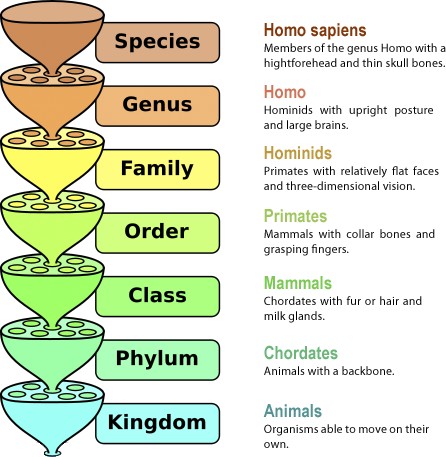 Here we sit on the Earth, orbiting around a medium-sized star with a number of other objects. What happened, 4.5 billion years ago, that resulted in the formation of our Solar System?
Here we sit on the Earth, orbiting around a medium-sized star with a number of other objects. What happened, 4.5 billion years ago, that resulted in the formation of our Solar System?
When scientists approach a question like this about the natural world, we start by trying to classify whatever it is that we are examining. Scientists like to put objects into groups that might have common chemistry or a common history and evolution. For example, we put animals into groups using the Linnaean System and this helps us understand how these animals function, live, and how they evolved.
Your goal in lab this week is to examine how astronomers have classified the objects in our solar system.
There are lots of way to classify a group of objects. For example, in classifying animals, we could classify them by how tall they are or how many legs they have or how well they can see. However, this wouldn’t be a scientifically useful classification scheme. While there are a number of ways to classify the objects in our solar system, we typically look at an object’s chemical composition and its orbital properties.
Chemical Composition—what type of materials is a given object made of?
Think about baking a cake—there are some common materials that you will almost always use such as flour, sugar, eggs, baking soda, salt, etc. When making a solar system, we also have common materials that are just floating around the galaxy in clouds of gas and dust including Hydrogen and Helium gas, little bits of dust (tiny rock particles), Ices (water, methane, ammonia), and Iron metal (Fe). Different proportions of each of these initial ingredients is what can be used to build a solar system object.
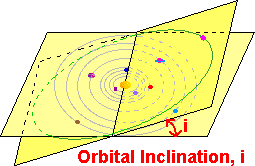 Orbital Properties—how “well-behaved” is an object’s orbit? How does a given object orbit the Sun (or, in the case of a satellite, how does it orbit its parent planet)? Is the orbit nearly circular or is it highly elliptical? Is the orbit within the plane of the solar system or is the orbit highly tilted (inclined) with respect to the Earth’s orbit around the Sun? Some orbits are very circular and not tilted (think Earth) and others are more elliptical and tilted (think Pluto).
Orbital Properties—how “well-behaved” is an object’s orbit? How does a given object orbit the Sun (or, in the case of a satellite, how does it orbit its parent planet)? Is the orbit nearly circular or is it highly elliptical? Is the orbit within the plane of the solar system or is the orbit highly tilted (inclined) with respect to the Earth’s orbit around the Sun? Some orbits are very circular and not tilted (think Earth) and others are more elliptical and tilted (think Pluto).
ACTIVITY 15.1: VISUALIZING THE SCALE OF THE SOLAR SYSTEM
“Space is big. You just won’t believe how vastly, hugely, mind-bogglingly big it is. I mean, you may think it’s a long way down the road to the chemist’s, but that’s just peanuts to space.”
― Douglas Adams, The Hitchhiker’s Guide to the Galaxy
We will start our Solar System study by thinking a little bit about the sizes of the planets and how far away they are from the Sun. We going to use a website to help us build a table of the true distances and those distances converted to a scale where Pluto (actually a Kuiper Belt object, but it gets to be a planet again for this exercise) is 100 m from the Sun, or just farther than the length of a football field. Then we will go outside to recreate this!
Go to https://www.exploratorium.edu/ronh/solar_system/index.html. To create the solar system on a 100-meter scale, you need to enter a scaling factor for the size of the Sun that you want to use—in our case, 23.5 mm is how large the Sun is on this scale, or just smaller than one inch across. Then complete this table:
|
Object |
Size (km) |
Scaled size (mm) |
Distance from the Sun (km) |
Scaled distance from the Sun (m) |
|
The Sun |
1,391,900 |
23.5 mm |
0 km |
0 m |
|
Mercury |
|
|
|
|
|
Venus |
|
|
|
|
|
Earth |
|
|
|
|
|
Mars |
|
|
|
|
|
Jupiter |
|
|
|
|
|
Saturn |
|
|
|
|
|
Uranus |
|
|
|
|
|
Neptune |
|
|
|
|
|
Pluto |
|
|
|
100 m |
Now let’s go outside to see what this looks like!
Remember that we can’t represent both the sizes and the distances to scale on one figure! But here is an approximate image of how far away everything is.

ACTIVITY 15.2: ANALYZING THE OBJECTS IN THE SOLAR SYSTEM
Let’s start by placing some objects into bins immediately so that we can focus down on to the question of “what a planet is.” Think about the main things that you know about planets. Think about what it means to you when someone asks you what a planet is.
- 1. What is the most basic thing that a given object in our solar system must do in order to be considered a planet?
- 2. Which objects in our solar system do NOT do this?
Now let’s pull some solar system objects out of the running for planet status right away at the beginning so we can focus on those objects which primarily orbit the Sun.

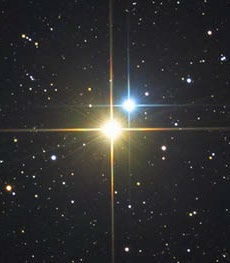
Above – (left) Alcor & Mizar, a quadruple star system in the constellation Ursa Major (the Big Dipper); (right) Albireo, a double- star system in the constellation Cygnus.
STARS – this is our first category of objects within a solar system.
- 3. How many stars are in our solar system?
It turns out that having only one star in a given system is relatively rare. When you look up at night at the stars, about half of those stars are actually binary star systems with two stars orbiting each other. Some are triple- and even quadruple-star systems!! Imagine living in a different solar system where you have two, three or even four suns in the sky.
The mass of the Sun is 1.99 x 1030 kg.
The mass of all of the other objects in our solar system combined is 2.67 x 1027 kg.
- 4. What percent of the mass of our ENTIRE solar system is contained within our star?
- 5. What are the basic properties of a star, or our Sun?
As we think about the solar system, as Earthlings, we often think that the Earth is a big deal, but the solar system is really all about the Sun. It is the vast Vast VAST majority of the mass of our solar system and really, the planets are just little dust bits orbiting around the Sun.
OK, so the Sun is a star and not a planet. Got it. Let’s move on!
Next, let’s remove the objects in our solar system that orbit around something other than the Sun. We’re going to call these SATELLITES. The image below shows the largest satellites scaled to size with Earth, Venus, Mars, Mercury, and Pluto.
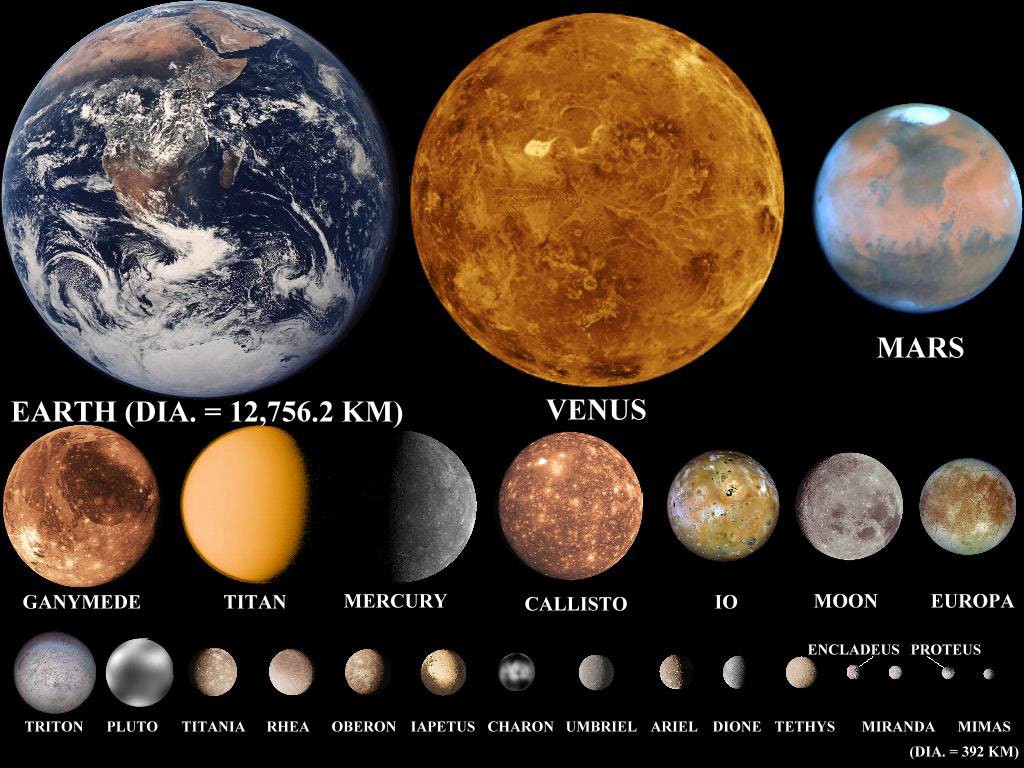
- 6. Can satellites be larger than planets?
- 7. How many satellites are larger than Pluto?
- 8. Can satellites be spherical?
- 9. If Ganymede or Titan were in orbit around the Sun, rather than Jupiter and Saturn (respectively), how would they be classified?
Now take a look at the data table below. Each row represents a different large object in our solar system that orbits the Sun. Column E tells you how many satellites each of the larger objects has.
- 10. Do all planets have satellites?
- 11. What is the basic definition of a satellite?
DATA TABLE – Lots of data about objects that orbit the Sun including their chemical compositions and orbital properties. We will come back to this chart and its color scheme throughout the rest of the lab.
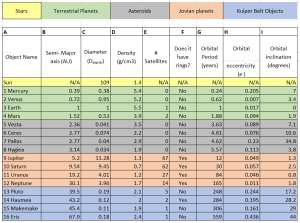
OK, now we are down to objects that are in orbit around the Sun. We could stop here and say that any object in orbit around the Sun is a planet. But let’s see if we can classify these objects any further based on their chemical compositions and orbital properties.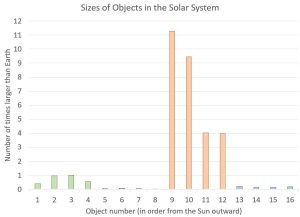
Next let’s look at sizes of these objects…
To the right is a plot of the sizes of the 16 different objects in the data table above in terms of their diameter or the number of times larger (or smaller) they are than the Earth.
The x-axis is just the object number in order from closest to the Sun outward. The colors match the row colors in the table above and represent the groups into which planetary geologists put these objects.
- 12. Which group of objects are the largest objects in the solar system (except for the Sun)?
- 13. Which group or groups of objects are the smallest?
Chemical Composition
The easiest way to get a quick idea of what a given planetary object (or any object, really) is made of is to look at its density. Recall that density is the amount of mass in a given object divided by its volume, or how large it is. Think about a tennis ball, which is mostly air, and how that feels lighter (or less dense) than a pool/billiard ball, which is solid. Imagine that you had a sphere of the same size made entirely out of iron—it would weigh approximately 2.6 pounds! Iron is a very dense element.
The materials available to create a solar system anywhere in the galaxy include gasses (mostly hydrogen and helium), ices (water, ammonia, and methane), dust particles (tiny rocks), and metallic iron (solid Fe). If we compare the densities of these solar system objects to the densities of these four main materials, we can get a rough idea of what the objects are made of. You can do that using the table above, but here is a graph!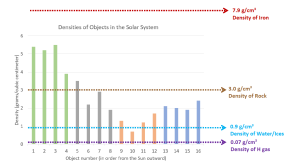
The density of the planetary object is on the y-axis and given in grams/cubic centimeter (or g/cm3). The densities of the common solar-system-forming materials are shown as well. In order to estimate what a given object is made of, you simply look at what types of materials you’d have to combine in order to get that object’s density.
For example, let’s choose the Earth. The Earth’s average density is 5.5 g/cm3 which lies between the densities of rock and iron. We would assume, therefore, that the Earth is primarily made up of rocks and iron metal and indeed, this is the case! About half of the radius of the Earth is all iron (the inner and outer core) while the outer half of the Earth is all rock. And so, Earth is a rocky-metallic body.
- 14. Which group of objects has the highest densities?
- 15. What two materials are these objects a mixture of?
- 16. Within this group of objects, which has the largest iron core?
- 17. Within this group of objects, which has the smallest iron core?
- 18. Which group of objects has the lowest densities?
- 19. Would any of these objects float on water (if so, which one)? How do you know?
- 20. Using what you know about this group of objects, what are they PRIMARILY composed of?
- 21. Given the data in the graph above, is it likely that any of these objects have rocky cores? How do you know?
- 22. What two materials are the Asteroids and Kuiper Belt Objects made up of?
- 23. Which of these two groups has more rock than ice?
- 24. Which of these two groups has more ice than rock?
- 25. Is it possible that some of these smallest objects have metallic iron in them? Explain your response.
And so we generally talk about (1) high-density solar system objects that are mostly rock and metals, (2) low density objects that are mostly gaseous and icy, and (3) medium-density objects that are rocky and icy. However, recognize that the densities within these groups can vary widely based on what exactly each specific object is made of.
- 26. Match the category of objects with their general density (low, medium, or high).
Next let’s check out the Orbital Properties of these various objects. Recall that Kepler figured out his three laws of planetary motion that all objects in orbit around another object follow.
Kepler’s First Law is that A Planet Moves on an Elliptical Orbit with the Sun at one Focus. An ellipse is a squashed circle and the amount of “squashiness” or how elliptical the orbit is can be measured with the eccentricity, e. Recall that the e = 0 for a circle and approaches e = 1 for highly elliptical orbits, like that of a comet.
When we are looking down on the northern pole of the Earth and looking at how elliptical these orbits are, we are only seeing a two-dimensional picture of what a true orbit looks like around the Sun.
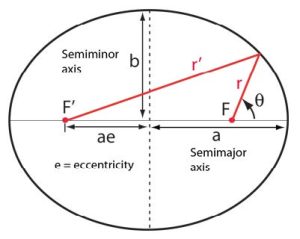
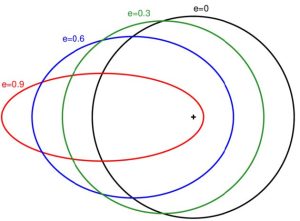
If we now look at the orbits from the side, or edge-on to the Earth’s orbit around the Sun, we can see that some orbits are also tilted with respect to the Earth-Sun orbital plane and therefore different objects will travel above and below the plane of the solar system. The angle that the orbit is above or below the Earth-Sun orbital plane is called the inclination of the orbit. It can range from 0° to ±90° (which is straight up and down). Note that Pluto’s orbit is very inclined to the plane of the solar system.
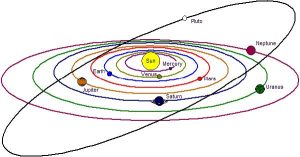
The two graphs below show you the orbital eccentricities and inclinations for these solar system objects. As planetary geologists, we look for “well-behaved” orbits vs. “less well-behaved” orbits. The BEST orbit would be one that is a perfect circle exactly aligned with the Earth’s orbit around the Sun. A much less well-behaved orbit would be highly elliptical and tilted with respect to the Earth’s orbit around the Sun.
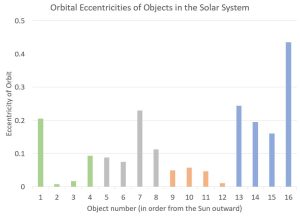
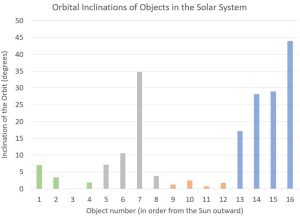
- 27. Which TWO classes of objects have the most elliptical orbits on average?
- 28. Which TWO classes of objects are tilted the least to the plane of the solar system?
- 29. Of the Terrestrial Planets, which one is the least well-behaved?
- 30. Why is it harder for that planet to have a well-behaved orbit at its location in the solar system?
- 31. In general, characterize these different groups of objects based on their orbital properties.
- 32. Having looked at all of these data, how can you classify these four groups of objects when you combine what you know about their chemical compositions and their orbital properties?
- 33. Match these four groups of objects to the best description.
- 34. In which group does Pluto best fit?
- 35. What is it about Pluto that makes it not a good fit for either of the planet groups?
Now, for fun, go to https://www.exploratorium.edu/ronh/age/, enter your birthday and find out when your next birthdays are on the different planets in the solar system.
- 36. Which member of your group has a birthday on Jupiter next?
- 37. Which member of your group has a birthday on Mercury next?
